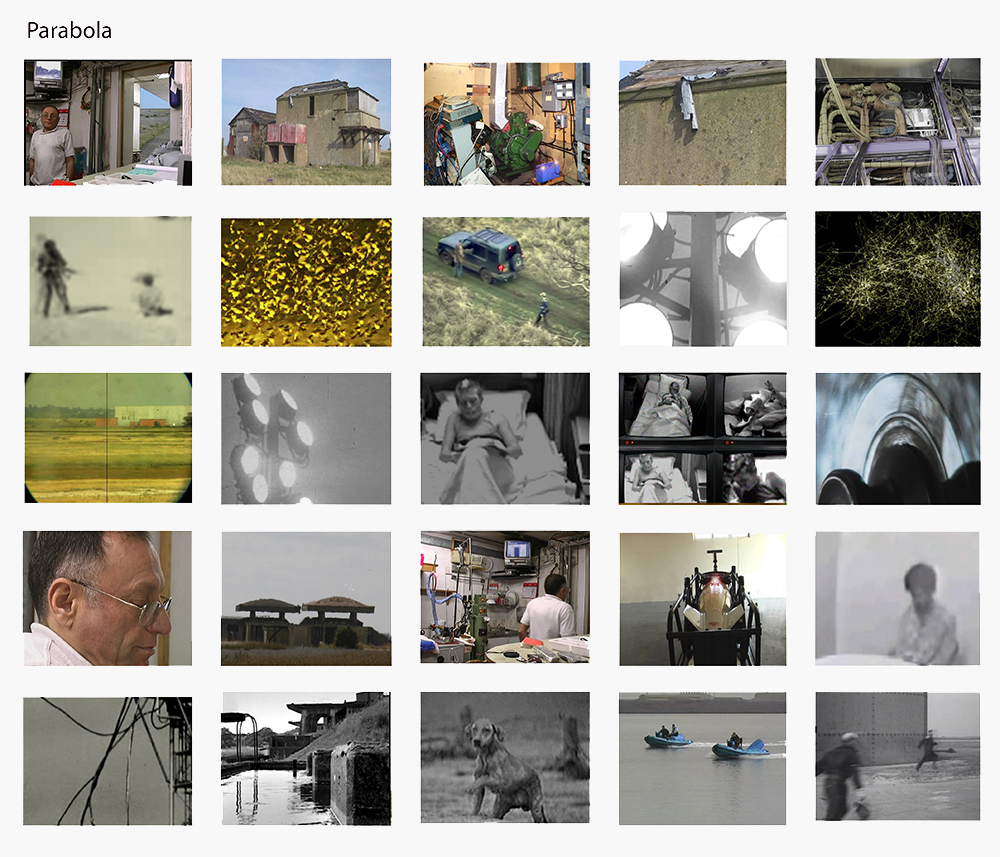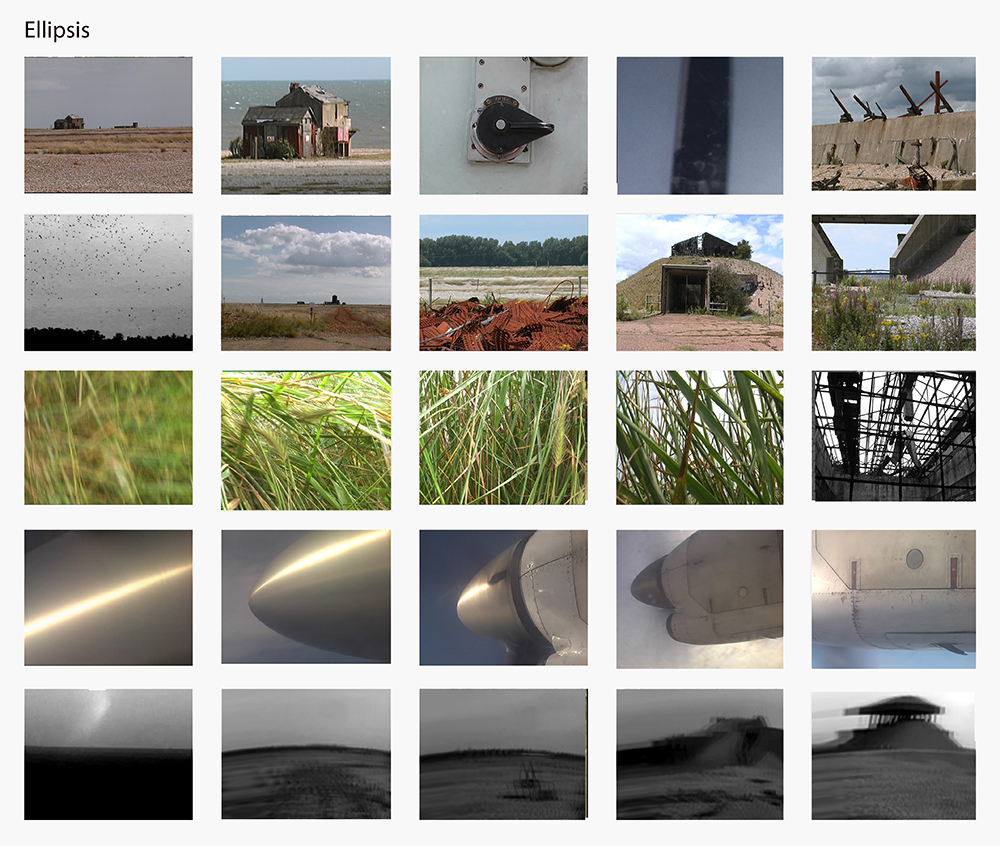2011 - Conic trilogy - Parabola, Ellipsis, Hyperbola | single screen videos 23, 9, 27 mins
Conic Trilogy
During the course of 2009 Nooshin Farhid made a number of research visits to Orford Ness on the Suffolk coast. This small island has been the site of a number of activities over the years which touch upon the political and includes scientific research, espionage, international communications, military testing (testing of the first atomic bomb) and now as a National Trust wildlife reserve. This innocuous, absolutely flat piece of land is multi layered in its usage, past and present, remnants of this multiple history are still in evidence, there are man-made features whose functions are still on the official secrets list. Consequently the architecture of the numerous buildings is ‘function specific’, built for particular purposes both in terms of their use but also their invisibility from the outside world.

In making these three video works Farhid implemented a mathematical concept based on a geometry of surfaces and curves: Parabola, Ellipsis and Hyperbola. Mathematically these forms are all obtained by intersecting a “conical surface” with a plane; and depending on how the plane approaches the cone one of these different forms emerges. This conceptually emphasises the idea of the intersection between different narratives, disciplines and ideologies. However these words, through their Greek etymologies, also have non mathematical characteristics, referring to: ‘a fictitious narrative’ (parable), ‘missing words in a sentence’ (ellipse), and ‘extravagant statements used to express a strong impression’ (hyperbole). For instance the voiceover in each video is constructed in such a way as to reflect the particularity of these three terms (the text is written by Farhid, however, she implemented the scientific parts such as the information about the chemical weapons from other sources and re-appropriated them into the body of the text).

Nooshin Farhid’s approach to video making is similarly complex and explores multiplicity, her images are sourced from a wide spectrum of material including her own real time footage, she is interested in crossing boundaries and in relation to this eclectic assembling of visual material there is an interest in mixing genres. For example whilst she has undertaken extensive research at Orford Ness Conic Trilogy is not a documentary, nor is it specifically about the island but much more to do with a series of interweaving narratives were journeys are begun, trails go cold only to reappear again in another guise. Time moves forward at the same time that it goes backward reflected in her use of black and white images and then their slippage into colour, there is a suggestion of entanglement and betrayal, surveillance and suppression as the dispassionate voiceover addresses an anonymous someone. A central character situated in what might be perceived as a control room filled with activated equipment, monitors, keyboards, cables and instruments with flashing lights placidly goes about his business every now and again addressing us without speaking.

Structurally we are presented with an almost overwhelming amount of powerful imagery which is carefully edited in order to maintain an edge between the rational and the irrational, what appears as a dialogue between unnamed and invisible individuals could be taken as a metaphor for the power games played off between opposing ideologies. What characterises this imagery is its representation of the effects of failed systems, or of systems in the process of collapsing of being unable to hold together with any sense of continuity, this is emphasised in her use of the fractured narrative and the constant shifting between genres and technical quality as if the film stock itself is unstable. But, more importantly, is her engagement with the politics of change and a recognition of the frailty of current political systems.
text: Tara Gallo
Definitions
Parabola, Ellipse, Hyperbole: Hyperbole,
Ellipsis and Parable Gemomery
• Parabola (from Greek παραβολή meaning, juxtaposition and application) is one of the most familiar plane curves. It is the trajectory of projectile under a parallel gravitational field. It also can be described as the intersection of plane with a conic surface when the plane is parallel to a side of the cone. The earliest work to show of the conic sections was Menaechmus (4th century B.C.), a student of Plato and Eudoxus. In the Cartesian co-ordinates, the equation of this curve can be written as .
• Ellipse (from Greek ελλειψισ meaning “to come short”) is perhaps the curve most seen by people. Of course, the circle is a more familiar curve, but even circles are most often seen as ellipses due to the rules of perspective. The orbits of planets under Newtonian gravitational law are elliptic. An ellipse can also be described as the intersection of a plane with a conic surface when the inclination of the plane to the base of the cone comes short of the inclination of sides to the base. In the Cartesian co-ordinates the equation of an ellipse can be written as . As it can be seen, for an ellipse, falls short of the same quantity in a parabola.
• Hyperbola (from Greek υπερβολή meaning “to exceed”) is the third conic section. The trajectory of a moving object with a large initial velocity in a Newtonian gravitational field can be a hyperbole. A hyperbole can be described as the intersection of a plane with a conic surface when the inclination of the plane to the base of the cone exceeds the inclination of sides to the base. In the Cartesian co-ordinates the equation of an ellipse can be written as . As it can be seen, for an ellipse, exceeds the same quantity in a parabola.
Common Parlance
All three preceding geometric terms are used in common parlance with analogous sense.
• Parable (from the same Greek root as parabola) meaning a fictitious narrative or an allegory.
• Ellipsis (again from the same Greek root as ellipse) meaning the omission of one or more words in a sentence, which would be needed to complete the grammatical construction or fully to express the sense. In this relation in Oxford English Dictionary the following from Pope is quoted: “the Ellipsis, or speech by half-words [is the peculiar talent] of ministers and politicians”.
• Hyperbole meaning a figure of speech consisting of extravagant statements, used to express strong feeling or produce a strong impression, and not to be understood literally.
Exhibition:
2011 -Conic Trilogy, Solo Exhibition, Beaconsfield, London